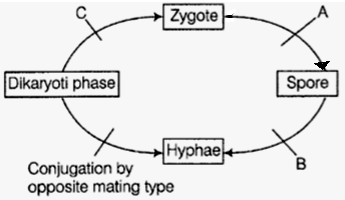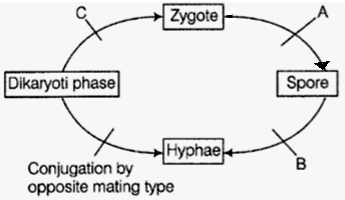The given below figure shows a generalised life cycle of a fungus. Identify A, B and C from the given option.

A
B
C
(1)
Meiosis
Fertilisation
Meiosis
(2)
Meiosis
Mitosis
Fertilisation
(3)
Mitosis
Meiosis
Fertilisation
(4)
Mitosis
Fertilisation
Meiosis
नीचे दी गयी आकृति एक कवक के सामान्यीकृत जीवन चक्र को दर्शाती है। दिए गए विकल्प में से A, B और C को पहचानें।

A
B
C
(1)
अर्धसूत्रीविभाजन
निषेचन
अर्धसूत्रीविभाजन
(2)
अर्धसूत्रीविभाजन
समसूत्री विभाजन
निषेचन
(3)
समसूत्री विभाजन
अर्धसूत्रीविभाजन
निषेचन
(4)
समसूत्री विभाजन
निषेचन
अर्धसूत्रीविभाजन

A
B
C
(1)
Meiosis
Fertilisation
Meiosis
(2)
Meiosis
Mitosis
Fertilisation
(3)
Mitosis
Meiosis
Fertilisation
(4)
Mitosis
Fertilisation
Meiosis

A
B
C
(1)
अर्धसूत्रीविभाजन
निषेचन
अर्धसूत्रीविभाजन
(2)
अर्धसूत्रीविभाजन
समसूत्री विभाजन
निषेचन
(3)
समसूत्री विभाजन
अर्धसूत्रीविभाजन
निषेचन
(4)
समसूत्री विभाजन
निषेचन
अर्धसूत्रीविभाजन
Read the following statements regarding archaebacteria.
I. Their cell wall lacks peptidoglycan.
II. They contain membrane bound organelles.
III. These have distinct ribosomal RNA sequence.
IV. Lipid in cell membrane of archaebacteria have different structure than those in all other organisms.
Choose the incorrecct option.
(1) I and II
(2) Only II
(3) Only IV
(4) III and IV
आद्य जीवाणु के संबंध में निम्नलिखित कथनों को पढ़ें।
I. उनकी कोशिका भित्ति में पेप्टीडोग्लाइकन का अभाव होता है।
II. उनमें झिल्ली आबद्ध कोशिकांग होते हैं।
III. इनमें अलग-अलग राइबोसोमल आरएनए अनुक्रम होते हैं।
IV. आद्य जीवाणुओं की कोशिका झिल्ली में लिपिड अन्य सभी जीवों की तुलना में अलग संरचना होती है।
गलत विकल्प चुनें।
(1) I और II
(2) केवल II
(3) केवल IV
(4) III और IV
A bacterium divides every 35 minutes. If a culture containing 105 cells/mL is grown for 175 minutes, what will be the cell concentration/mL after 175 minutes?
(1) 5 × 105 cells
(2) 35 × 105 cells
(3) 32 × 105 cells
(4) 4.175 × 105 cells
एक जीवाणु हर 35 मिनट में विभाजित होता है। यदि 105 कोशिकाएँ/एमएल युक्त कोई संवर्ध 175 मिनट के लिए उगाया जाता है, 175 मिनट के बाद कोशिका सान्द्रता/एमएल क्या होगी?
(1) 5 × 105 कोशिकाएँ
(2) 35 × 105 कोशिकाएँ
(3) 32 × 105 कोशिकाएँ
(4) 4.175 × 105 कोशिकाएँ
Dikaryotisation (n + n) in Agaricus is brought about by
(1) clamp connections
(2) somatogamay between two hyphae of different strains
(3) Both (1) and (2) are correct
(4) basidiospores
ऐगैरिकस में द्विकेंद्रकीयन (n + n).............. द्वारा होता है।
(1) क्लैम्प बंधन
(2) अलग-अलग प्रभेदों के दो हाइपी के बीच सोमाटोगैमी
(3) दोनों (1) और (2) सही हैं।
(4) बैसीडियम बीजाणु
Which one of the following shows heterothallism?
(1) Rhizopus
(2) Bacterium
(3) Cycas
(4) Ricinus
निम्नलिखित में से कौन सा विषमजैविकता दर्शाता है?
(1) राइजोपस
(२) जीवाणु
(3) साइकैस
(4) रिसिनस
Which of the following is a 'cyanophage'?
(1) S-13
(2)
(3) SV-40
(4) LPP-1
निम्नलिखित में से कौन सा 'नील हरित भक्षकाणु' है?
(1) S-13
(2)
(3) SV-40
(4) LPP-1
The common characteristic showning by mushroom, smut and rust
(1) is characterised by presence of basidiocarps
(2) is characterised by presence of ascocarps
(3) all are pathogen
(4) all are saprophytic in nature
मशरूम, कंठ और कीट द्वारा दिखाए गये सामान्य लक्षण
(1) बेसिडियोकार्प की उपस्थिति के द्वारा अभिलक्षित होता है।
(2) एस्कोकार्प की उपस्थिति के द्वारा अभिलक्षित होता है।
(3) सभी रोगजनक हैं
(4) सभी प्रकृति में मृतजीवी होते हैं।
Which one exhibits the character of a protozoan during one phase of its life cycle and character of fungi in another phase of its life cycle?
(1) Water moulds
(2) Psilophytes
(3) Slime moulds
(4) Diatoms
कौन सा एक अपने जीवन चक्र के एक चरण के मध्य एक प्रोटोजोआ के लक्षण और जीवन चक्र के अन्य चरण में कवक के लक्षण का प्रदर्शन करता है?
(1) जल कवक
(2) साइलोफाइट
(3) अवपंक कवक
(4) डायटम
Spirochaetes is/are
(1) a class of viruses
(2) myxobacteria
(3) spiral-shaped bacteria
(4) richittsias
तरंगाणु है/हैं
(1) विषाणुओं का एक वर्ग
(2) श्लेष्मजीवाणु
(3) सर्पिलाकार जीवाणु
(4) रिकेट्सिया
Which of the following organisms completely lack cell wall, they are the smallest living cells known and can survive without oxygen?
(1) Mycoplasma
(2) Euglenoids
(3) Slime moulds
(4) All of these
निम्नलिखित में से किस जीव में पूरी तरह से कोशिका भित्ति की कमी होती है, वे ज्ञात सबसे छोटी सजीव कोशिकाएँ होती हैं जो ऑक्सीजन के बिना जीवित रह सकती हैं?
(1) कवक द्रव्य
(2) यूग्लीनॉइड
(3) अवपंक कवक
(4) ये सभी






